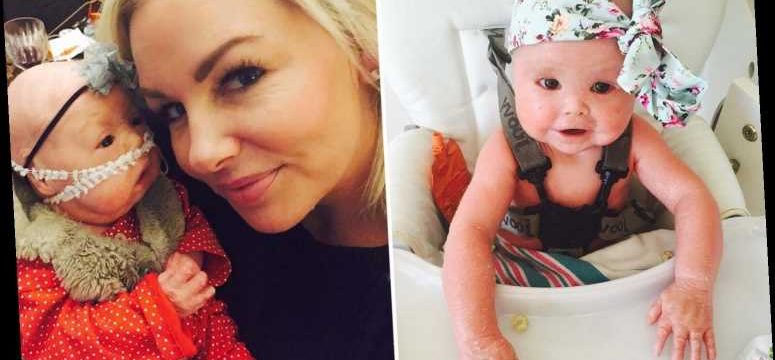A MOTHER has revealed she has to wear gloves to cuddle her little girl as the slightest touch leaves her in agony.
Little Harper Foy was born with a rare and severe genetic disorder which covered her in thick skin that restricts breathing and blood flow.
After Harper was born she had to have emergency surgery to save her arms and legs.
Doctors soon diagnosed the youngster with Harlequin lchthyosis.
Her parents Angie, 43 and Kevin, 42 have now revealed that they still have to bathe her four times a day to soothe her skin.
Angie was unable to touch Harper for the first two weeks of her life without wearing protective gloves.
This was due to the sensitivity of Harper’s skin.
The couple, from Washington, US said Harper, now four, has come a long way since she was born, and has even managed to land a modelling contract.
“She's a miracle”, Angie said.
"She signed a modelling contract which I hope will increase awareness of the condition.
"The more people that know about the condition, the less people will stare or think she's scary.
"A lot of kids don't want to touch her because they think she's contagious so it's important to raise awareness”.
She added that Harper has so much self confidence despite the setbacks the youngster has faced.
Angie said she had a normal pregnancy and that the family were shocked when there were problems with Harper.
Harper is the couple’s third child and Angie said she felt “fine throughout the pregnancy”.
What is Harlequin lchthyosis?
Harlequin lchthyosis is a genetic disease that mainly effects the skin.
- Ichthyosis is a condition that causes widespread and persistent thick, dry, “fish-scale” skin.
- There are at least 20 different types of ichthyosis. Some types are inherited at birth and other types are acquired during adulthood.
- There’s no cure for ichthyosis, but a daily skincare routine usually keeps the symptoms mild and manageable.
- Most people with ichthyosis have inherited a particular faulty gene from their parent. The signs and symptoms of inherited ichthyosis appear at birth or within the first year of life.
- The faulty gene affects the rate at which the skin regenerates – either the shedding of old skin cells is too slow, or the skin cells reproduce at a much faster rate than they can shed old skin. Either way, this causes a build-up of rough, scaly skin
- Ichthyosis vulgaris is the most common type of inherited ichthyosis, affecting 1 in 250-1,000 people.
- Harlequin ichthyosis is extremely rare, but the scaling is severe and requires intensive care at birth.
- There’s no cure for ichthyosis, but moisturising and exfoliating the skin daily can help prevent dryness, scaling and the build-up of skin cells.
- People with severe ichthyosis may need to spend several hours a day caring for their skin.
- People with mild ichthyosis have a normal lifespan. However, the most severe inherited types can be life threatening.
Source: NHS Choices
"I had no idea she had the condition because I had a normal pregnancy, everything went well and I felt fine.
"I'll never forget, when I was having my caesarean, the doctor told my husband to get out his camera and that's when it all changed.
"I knew something was wrong with her but it was all a bit of a blur”.
At the time, doctors had never seen anything like it and documented Harper’s journey.
Angie said that every day was an “unknown” for the family.
"We just had to bathe her all day every day and then about three weeks later, the skin came off."
Now the couple spend four hours a day bathing Harper and lathering her in soothing balm to make her comfortable.
Angie said: "Her skin care routine is time consuming because she makes new skin every couple of hours.
"She's always shedding her skin and it's itchy, dry and uncomfortable.
"Most with the condition lose their feet and hands as the skin is so tight, it restricts the blood flow, but doctors made incisions in her wrists and ankles so that wouldn't happen”.
Sadly, Harper did lose the tips of her fingers on her left hand but Angie said she was lucky to have not lost her limbs.
"She would have had this severe skin condition and be in a wheelchair so that would have been even more devastating."
Harper’s condition affects just one in 500,000 births and it’s hoped that her presence on the modelling scene will raise further awareness.
Angie said: "Different disabilities are being shown now in modelling.
"There are deaf, blind and down syndrome models showing kids who are different which is amazing.
"Harper needs to know it's just skin.
"She's so fun and spunky and just a hoot. She loves to sing and dance and she's so special.
"She loves photo shoots and if you put some music on, she does her thing.”
Source: Read Full Article






